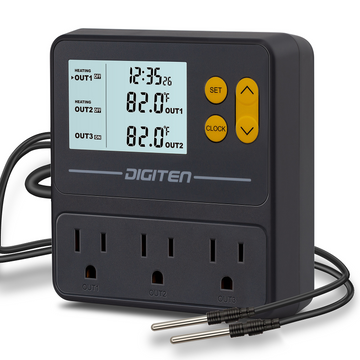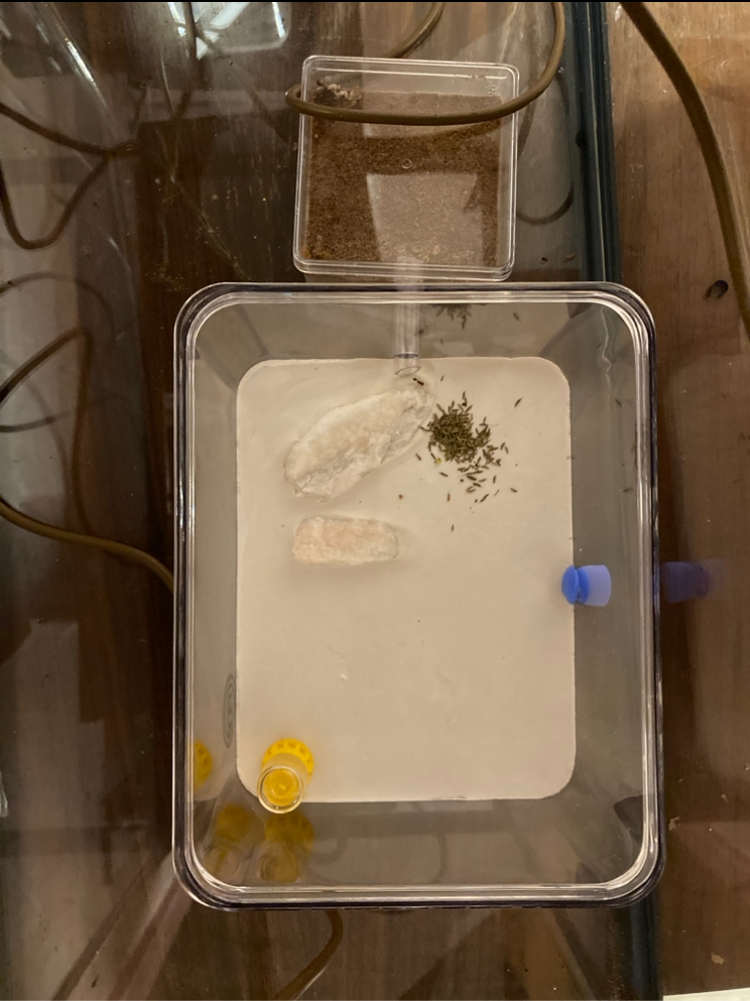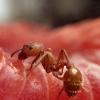- Formiculture.com
- Forums
- Gallery
- Members
- Member Map
- Chat

Pogonomyrmex occidentalis concerns and questions
Started By
Mirandarachnid
, Jan 2 2024 10:05 PM
4 replies to this topic
#1
 Offline
-
Posted January 2 2024 - 10:05 PM
Offline
-
Posted January 2 2024 - 10:05 PM
Hi everyone!
I have a few questions about my ants.
I have them in the ant den from antgear.com. For the first week I had them, they were pretty active. Foraging, building up a trash pile, Queen was laying eggs. I did not have a liquid feeder, so I had a wet cotton ball on the rock in their outworld that I kept saturated, which was not ideal. When my liquid feeder came in, they immediately started plugging it up with sand and seeds. I’ve read that they do not like water close to the nest entrance, so I gave them a larger outworld and put the feeder as far away from the entrance as I could.
After I gave them the new outworld, I saw one or two ants in it at a time on the first day. They quickly plugged up the tube with sand, and it has been four days since I’ve seen an ant in the outworld. I’m not seeing any evidence of foraging, or any trash being moved out. The egg pile seems to have been reduced to a few eggs.
The outworld has a completely open top, perfect cast floor, and a couple of rocks that I got out of a bag of landscaping rocks. The rocks were washed in dish soap and hot water.
I’ve read that they plug up their nest entrance at night in the wild, but mine are keeping it shut at all times.
Could this be a heating issue? I currently have their setup inside of a 10 gallon aquarium with a heat cable draped inside it to raise the ambient temperature. I’ve been thinking of getting an additional heat source to turn on during the day to indicate that it is daytime, since turning on the light doesn’t seem to be making a difference.
Is this behavior something I even need to be concerned about? I’m much more used to tarantulas, and doing nothing is their norm. And the husbandry is basically the same. When in doubt (and they are provided with what they require) do nothing. But I know small colonies are more delicate so I want to make sure I’m not messing up somewhere.
They have 11 workers. There have been a couple of deaths, but they were some of the smallest workers and that was before the new outworld.
I have a few questions about my ants.
I have them in the ant den from antgear.com. For the first week I had them, they were pretty active. Foraging, building up a trash pile, Queen was laying eggs. I did not have a liquid feeder, so I had a wet cotton ball on the rock in their outworld that I kept saturated, which was not ideal. When my liquid feeder came in, they immediately started plugging it up with sand and seeds. I’ve read that they do not like water close to the nest entrance, so I gave them a larger outworld and put the feeder as far away from the entrance as I could.
After I gave them the new outworld, I saw one or two ants in it at a time on the first day. They quickly plugged up the tube with sand, and it has been four days since I’ve seen an ant in the outworld. I’m not seeing any evidence of foraging, or any trash being moved out. The egg pile seems to have been reduced to a few eggs.
The outworld has a completely open top, perfect cast floor, and a couple of rocks that I got out of a bag of landscaping rocks. The rocks were washed in dish soap and hot water.
I’ve read that they plug up their nest entrance at night in the wild, but mine are keeping it shut at all times.
Could this be a heating issue? I currently have their setup inside of a 10 gallon aquarium with a heat cable draped inside it to raise the ambient temperature. I’ve been thinking of getting an additional heat source to turn on during the day to indicate that it is daytime, since turning on the light doesn’t seem to be making a difference.
Is this behavior something I even need to be concerned about? I’m much more used to tarantulas, and doing nothing is their norm. And the husbandry is basically the same. When in doubt (and they are provided with what they require) do nothing. But I know small colonies are more delicate so I want to make sure I’m not messing up somewhere.
They have 11 workers. There have been a couple of deaths, but they were some of the smallest workers and that was before the new outworld.
Never trust an isopod.
#2
 Offline
-
Posted January 2 2024 - 11:34 PM
Offline
-
Posted January 2 2024 - 11:34 PM
It may be likely that the nest is simply too big at the moment for the colony and it's stressing them out. Heating looks like it should be fine and as long as the nest is hydrated, i.e. not completely dry, it shouldn't be a hydration issue either. If they continue to dwindle over the next week or two, it may be wise to move them back into a test tube setup and to use a tub-and-tube setup until they're at a larger size. Ants can sometimes be tricky when their colonies are small due to their natural ability to be extremely crass in captivity, so don't lose hope! Soon enough they'll get to a state where the, "when in doubt do nothing" is the best husbandry to provide.
- Mirandarachnid likes this
#3
 Offline
-
Posted January 3 2024 - 3:12 AM
Offline
-
Posted January 3 2024 - 3:12 AM
This species also has a big advantage in that they can do a bit of foraging to stockpile a large amount of “shelf stable” seeds that the colony can live off for weeks without having to send out any more risky foraging trips. In a small colony, each worker is vitally important, so they are much less likely to risk their lives by leaving the nest. All the Pogonomyrmex colonies I’ve had behaved this way, granted they were much smaller even than yours.
- Mirandarachnid, rptraut and Full_Frontal_Yeti like this
"The ants are a people not strong, yet they prepare their meat in the summer." Prov. 30:25
Keep ordinary ants in extraordinary ways.
Keep ordinary ants in extraordinary ways.
#4
 Offline
-
Posted January 3 2024 - 9:06 AM
Offline
-
Posted January 3 2024 - 9:06 AM
I think it is as Antdrew says, colony size.
Mine arrived with 28, a well established size and did not do this, but then they were out past their early stage and had only a couple nanitics left among them.
At this early stage they might also do better in darkness if they are feeling small and vulnerable still.
One of the biggest changes in their behavior was numbers. Once they got up to the 100 zone, they got aggressive as a group, where they had been more timid before.
A bump on their table would send them fleeing into the nest and huddle up together around the brood.
Later when nearing the 100, a bump brings out of the nest a swarm of ready to fight aggressive ants looking to bite and sting whatever is disturbing them.
Also just to say i love this thing:
https://www.digiten....om-fermentation

Two temp probes let me have one in nest and one near it for ambient.
My house is like a tent for thermal properties, so i worried a bit about them on overnights and such during winter.
But also helps me just be lazy and feel safe knowing their temps are kept well controlled year round without much effort on my part.
Two plugs temp probe controlled and one timer plug for lighting. Some of the best $40 i ever spent.
I now use both temp probes in nest as they have grown.
- Mirandarachnid, rptraut and PDuncan67 like this
#5
 Offline
-
Posted January 3 2024 - 7:17 PM
Offline
-
Posted January 3 2024 - 7:17 PM
Thanks for the responses! They were very helpful.
I had not considered the fact that going outside of the nest is very much a risk for them in the wild. I put the lid on the outworld leaving its vents open (it’s intended to be a storage container for fruit). I left my house for about five hours and by the time I got back, they had opened up the tube and there was lots of evidence that they had been in the outworld.
I had not considered the fact that going outside of the nest is very much a risk for them in the wild. I put the lid on the outworld leaving its vents open (it’s intended to be a storage container for fruit). I left my house for about five hours and by the time I got back, they had opened up the tube and there was lots of evidence that they had been in the outworld.
- rptraut likes this
Never trust an isopod.
0 user(s) are reading this topic
0 members, 0 guests, 0 anonymous users
















